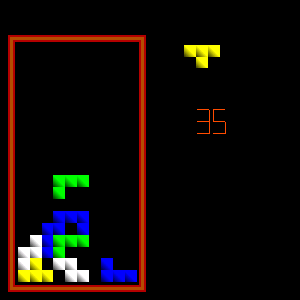
Playing the game
See using OpenGL with Arc for details on setting up OpenGL. To summarize, the files are in the opengl directory of the Anarki git. Rungl-arc.scm in DrScheme. Then load "tet.arc" into the Arc REPL, and the game will start.
To control the game, use the arrow keys. Left and right arrows move the tile. Up-arrow rotates the tile, and down-arrow drops it faster. When the game ends, "s" will start a new game.
Implementing games in Arc
Note that Arc itself doesn't have any graphics support, or any way to get at Scheme libraries. I hacked on Arc's implementation in Scheme to get access to the OpenGL libraries in PLT Scheme.My first concern with using Arc was speed. It turns out that Arc on a newish laptop is plenty fast to run the game, apart from occasional garbage collection glitches. The game itself doesn't require a fast refresh rate, and the amount of processing per frame is pretty small, so Arc manages just fine.
The biggest problem with implementing the game in Arc was the lack of useful error reporting in Arc; I should have emphasized this in Why Arc is bad for exploratory programming. Every time I wrote more than a few lines at a time, I'd encounter a mystery error such as "ac.scm::18267: car: expects argument of type
I found that game programming doesn't really let you take advantage of the REPL for development. OpenGL is very stateful, so I can't just call a drawing routine from the REPL to see how it's working. I usually had to restart my code, and often reload the Arc interpreter itself to clear up the various Scheme objects. When I worked incrementally, I often ended up with startup issues when I ran from the start (i.e. variables getting initialized in the wrong order).
One annoyance is Arc's lack of arrays. I used tables in some places, and lists of lists in other places, but vectors and arrays seem like really basic datatypes.
Another annoyance is OpenGL's lack of any text support. If you're wondering about the lack of text in the screenshot, that's why. I implemented a simple 7-segment number-drawing function to display the score.
Some (pretty obvious in retrospect) advice to other game writers: Figure out in advance if the Y axis points up or down. I wrote some of the code assuming Y increases going down before realizing that other parts of the code expected the Y axis to point up. Also, figuring out the origin and scale in advance is a good thing.
Another tricky part of game implementation is state transitions. Both startup and end-of-game caused me more difficulty than I expected.
Implementing the game became much more rewarding once I got a minimal interactive display working. I should have done that sooner, rather than implementing the algorithms up front. On the other hand, I found it useful to disable animation much of the time, using keypresses to single-step movement.
The game has no audio, since PLT Scheme doesn't have audio support.
It took me a long time to realize that the pieces in Tetris don't actually rotate around a fixed point. Once I realized this and hard-coded the rotations instead of implementing a rotation function, things became easier.
I display the piece in motion separately from the playing field array that holds the stationary pieces. When a line is completed, instead of updating the playing field array in place, I decided it would be interesting to write
I could make the code more "Arcish" with various macros (e.g. remove-rows in a functional way so it returns an entirely new playing field array, rather than updating the existing array (as I did in saveshape when a piece hits bottom). Writing the whole game in a functional style would be very difficult, as others have described.
w/matrix to wrap code in gl-push-matrix and gl-pop-matrix). But I decided to "ship early". Likewise I didn't bother implementing game levels, although the game does speed up as it progreses. And I've only made minimal efforts to clean up the code, so I'm not presenting it as a model of good style.
Conclusion
It's possible to write a playable game in Arc (with enough hacking on the language to get OpenGL support). I think it would have been considerably easier to write it in PLT Scheme directly, but the Arc implementation builds character. I was pleasantly surprised that Arc had enough speed to run the game. The Arc code works out to 389 lines for those keeping score; OpenGL is responsible for much of the length (50 lines just to display the score). I expect writing in Arc will be considerably easier if the language gets decent error reporting.